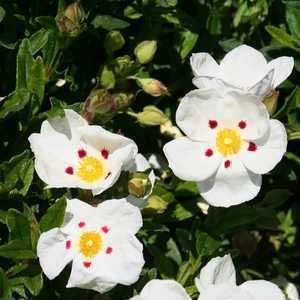Rank Species | Genus Cistus Higher classification Cistus | |
 | ||
Similar | ||
Gum rockrose cistus ladanifer klettar s bl mstrndi runni gar sk laplanta
Cistus ladanifer is a species of flowering plant in the family Cistaceae. It is native to the western Mediterranean region. Common names include gum rockrose, laudanum, labdanum, common gum cistus, and brown-eyed rockrose.
Contents
- Gum rockrose cistus ladanifer klettar s bl mstrndi runni gar sk laplanta
- Cistus ladanifer cistaceae
- Systematics and phylogeography
- Subspecies
- Uses
- References

It is a shrub growing 1–2.5 m (3 ft 3 in–8 ft 2 in) tall and wide. The leaves are evergreen, lanceolate, 3–10 cm long and 1–2 cm broad, dark green above and paler underneath. The flowers are 5–8 cm diameter, with 5 papery white petals, usually with a red to maroon spot at the base, surrounding the yellow stamens and pistils. The whole plant is covered with the sticky exudate of fragrant resin, the source of labdanum, used in herbal medicine and perfumery.

C. ladanifer is particularly well suited to the Continentalized Mediterranean climate, standing both long summer droughts and cold weather. It is an extremely aggressive plant which has taken over much of former farmland and grasslands in the mountain regions of central Spain and much of southern Portugal. In Spanish it is known as Jara pringosa meaning "sticky shrub". In Portuguese it is known as "esteva". It has been found to have mycorrhizal associations with Boletus edulis, Boletus rhodoxanthus, and Laccaria laccata.

Cistus ladanifer cistaceae
Systematics and phylogeography

C. ladanifer is placed within the C. salvifolius group within white and whitish pink flowered clade of Cistus species. The wide distribution and morphological variation of C. ladanifer across northern Africa, the Iberian peninsula, and southern France has resulted in the recognition of three sub-species: subspp. ladanifer, sulcatus, and africanus.
Phylogenetic and divergence dating methods found that C. ladanifer diverged during the Pleistocene, long after the opening of the Strait of Gibraltar around 5 mya, which supports a hypothesis of dispersal for this species. Although its seeds fall close to the maternal plant, C. ladanifer may have successfully dispersed due to its preference for disturbed habitats.
Subspecies
Uses
It is a popular ornamental plant, grown for its strongly resin-scented foliage and conspicuous flowers. Its leaves yield a fragrant oleoresin known as labdanum, used in perfumes, especially as a fixative.
This plant has gained the Royal Horticultural Society's Award of Garden Merit.
